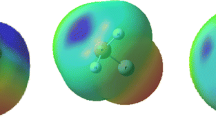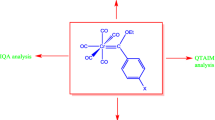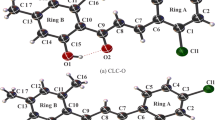Abstract
B3lyp/6–311++g** and mp2/6–311++g** calculations were used to analyze the interaction between CH3SO and HOCl. Nine (complex A: S1A–S9A) and five (complex B: S4B–S7B and S10B) minima were localized on the potential energy surface of CH3SO⋯HOCl complexes at b3lyp/6–311++g** and mp2/6–311++g** computational levels, respectively. The AIM and NBO theories were also applied to explain the nature of the complexes. Bonding energy of complexes A and B corrected with BSSE falls in the ranges of −0.4–−41.4 kJ·mol−1 and −6.9–−35.8 kJ·mol−1 at mp2/6–311++g** level, respectively. The results show that a novel oxygen bond complex (S6) exists in the system, besides hydrogen bond and chlorine bond. Especially, S6B−F, S6B−Br and S7B are blue shifted complexes compared with red shifted S6A, because the electron transfer occurs between LP1(S8) and σ*(O5-Cl7), resulting in the increase of O5-Cl7 and the decrease of vibrational frequency. The complex of S10B has characteristics of both red shift and blue shift.
Similar content being viewed by others
References
Hobza P, Sponer J. Structure, energetics, and dynamics of the nucleic acid base pairs: nonempirical ab initio calculations. Chem Rev, 1999, 99: 3247–3276
Li Y B, Zeng Q D, Wang Z H, et al. Constructing supramolecular nanostructure by hydrogen-bonding. Chinese Sci Bull, 2008, 53: 1613–1616
Aloisia S, Franscisco J S. Radical-water complexes in earth’s atmosphere. Acc Chem Res, 2000, 33: 825–830
Grabowski S J. High-level ab initio calculations of dihydrogen-bonded complexes. J Phys Chem A, 2000, 104: 5551–5557
Kollman P A, Liebman J F, Allen L C. Lithium bond. J Am Chem Soc, 1970, 92: 1142–1150
Vila A, Vila E, Mosquera R A. Topological characterization of intermolecular lithium bonding. Chem Phys, 2006, 326: 401–408
Ma J C, Dougherty D A. The cation-π interaction. Chem Rev, 1997, 97: 1303–1324
Cheng J G, Zhu W L, Wang Y L, et al. The open-close mechanism of M2 channel protein in influenza A virus: A computational study on the hydrogen bonds and cation-p interactions among His37 and Trp41. Sci China Ser B-Chem, 2008, 51: 768–775
Dumas J M, Gomel M, Guerin M. Molecular Interactions Involving Organic Halides. New York: John Wiley & Sons Ltd, 1983. 985–1020
Leu M T. Laboratory studies of sticking coefficients and heterogeneous reactions important in the antarctic stratosphere. Geophys Res Lett, 1988, 15: 17–20
Solimannejad M, Alkorta I, Elguero J. Stabilities and properties of O3-HOCl complexes: A computational study. Chem Phys Lett, 2007, 449: 23–27
Zhou Y F, Liu C B T. Theoretical study of HOCl adsorption on ice surface. J Phys Chem Sol, 1999, 60: 2001–2004
Turnipseed A A, Ravishankara A R, Dimethylsulfide: Oceans, atmosphere and climate. In: Restelli G., Ed. Proceeding of the International Symposium Held in Belgirate, Italy, 13–15 October, 1993. New York: Kluwer Academic, 1992. 185
Ravishankara A R, Rudich Y, Talukdar T, et al. Oxidation of atmospheric reduced sulphur compounds: Perspective from laboratory studies. Philos Trans R Soc London Ser B, 1997, 352: 171–182
Li X Y, Fan H M, Meng L P, et al. Theoretical investigation on stability and isomerizations of CH3SO isomers. J Phys Chem, 2007, 111: 2343–2350
Boys S F, Bernardi F. Calculation of small molecular interactions by differences of separate total energies. Some procedures with reduced errors. Mol Phy, 1970, 19: 553–556
Wu D, Li Z R, Hao X Y. An ab initio theoretical prediction: An antiaromatic ring π-dihydrogen bond accompanied by two secondary interactions in a “wheel with a pair of pedals” shaped complex FH⋯C4H4⋯HF. J Chem Phys, 2004, 120: 1330–1335
NIST Standard Reference Database No. 69, March 2003 ed. http://webbook.nist.gov/chemistry, 2005
Alabugin I V, Manoharan M, Peabody S, et al. Electronic basis of improper hydrogen bonding: A subtle balance of hyperconjugation and rehybridization. J Am Chem Soc, 2003, 125: 5973–5987
Wlendening E D, Weinhold F. Natural resonance theory: I. general formalism. J Comp Chem, 1998, 19: 593–609
Bader R F W. Atom in Molecules-A Quantum Theory. Oxford: Oxford University Press, 1990
Bader R F W. A quantum theory of molecular structure and its applications. Chem Rev, 1991, 91: 893–928
Popelier P L A. Characterization of a dihydrogen bond on the basis of the electron density. J Phys Chem A, 1998, 102: 1873–1878
Author information
Authors and Affiliations
Corresponding author
Additional information
Supported by the Foundation of Education Committee of Gansu Province (Grant No. 0708-11) and “QingLan” Talent Engineering Funds of Tianshui Normal University
About this article
Cite this article
Li, Z., Li, H., Liu, Y. et al. Weak interaction between CH3SO and HOCl: Hydrogen bond, chlorine bond and oxygen bond. Chin. Sci. Bull. 54, 3014–3022 (2009). https://doi.org/10.1007/s11434-009-0477-8
Received:
Accepted:
Published:
Issue Date:
DOI: https://doi.org/10.1007/s11434-009-0477-8




